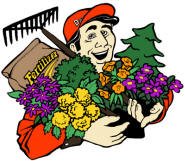The gorgeous weather of this past week has enabled us to accomplish much needed maintenance of the grounds, irrigation, painting and a general cleanup. Now with a freeze coming up, the irrigation system must be shut down including the pulling up of the heavy intake pipes. The entire three plus miles of pipe can be drained by gravity by the opening of several valves which will release water into the irrigation pond from which it came.
Large balled and burlapped trees have arrived and will remain in the fine gravel beds all winter if not sold this fall. Unfortunately, sales in the fall are much slower than in spring although fall is a great time to plant most trees and shrubs. Last winter’s severity has caused extra caution and hesitation in fall planting although the “new and revised” forecast is for a more “normal” winter.
Flower bulb planting for a spring show can go on through mid-February as long as a shovel or bulb planter is able to get through crust of frozen ground. War on the invasive non-native garlic mustard will continue into next spring and also on the Roundup resistant weed called mare’s tail that fortunately is easy to pull by hand.
Although most trees and shrubs in containers have been put away into winter storage huts, they still are available that they may be retrieved for customers to view and/or purchase.
The last day of October is a reminder that colder and wetter weather is coming soon but looking back some years, temperatures dropped quickly to 12º F in early November of 1991 after a long hot, dry summer. No doubt, this year and next will be no exception to wild swings in weather although a nice blanket of snow all winter would be a blessing for farmers and gardeners.
Some of the fall color that remains at the nursery is of Oxydendron arboretum (shown below, left) with its bright red oval leaves with some of the white spent flowers called racemes still hanging on the tree. Another fall beauty is the Weston’s Lollipop azalea (shown below, right) with flaming red foliage which has so far remained on the plants for 3 weeks! This deciduous azalea has extremely fragrant pink flowers in early summer plus the spectacular fall color show! Who needs burning bush?
Tom






